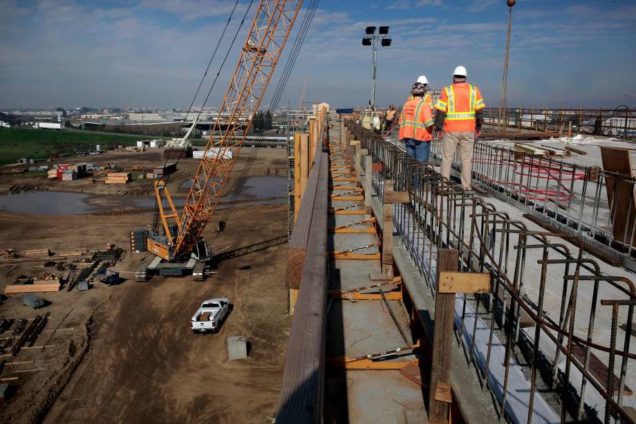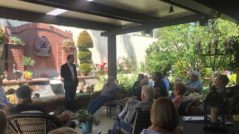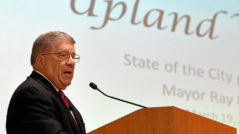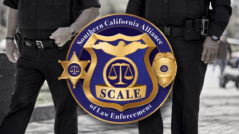Story By Kurtis Alexander | San Francisco Chronicle
A last-minute deal that Gov. Jerry Brown made with Republican lawmakers to win support for a 10-year extension of his signature climate program could cost the governor another top priority: high-speed rail.
In extending California’s cap-and-trade system of controlling greenhouse-gas emissions through 2030, lawmakers approved a Republican plan this week to put a constitutional amendment before voters that seeks to give the minority party more say over how the program’s money is spent. One-fourth of that money — more than $1 billion so far and $500 million projected a year in the future — goes toward high-speed rail, a project that Republicans widely oppose.
With the proposed $64 billion train line between Los Angeles and San Francisco facing not only Republican opposition but financial struggles, any cut in funding from the cap-and-trade program could be fatal.
“This absolutely calls into question the viability of high-speed rail going forward,” said Assemblyman Marc Steinorth, R-Rancho Cucamonga (San Bernardino County), who voted to extend cap and trade in part because of the proposed constitutional amendment. “If the bullet train can’t prove its worth, (this amendment) provides a pathway to ending the funding for the boondoggle once and for all.”
However, several dominoes must topple for Republicans to realize their desire to kill high-speed rail.
First, the proposed constitutional amendment must win voter approval when it’s on the ballot in June. The amendment calls for a one-time increase in the number of votes that the Legislature needs to approve how cap-and-trade money is spent, including the funds for the rail project.
The voting threshold would rise from a simple majority to two-thirds of both the Assembly and state Senate. That could hand leverage to Republican legislators, if they can break the Democrats’ current two-thirds hold on both houses.
However, the Legislature’s vote wouldn’t happen until 2024. Until then, funding would continue to flow to high-speed rail, which is already under construction on a 119-mile stretch between Madera and the Bakersfield area.
High-speed rail officials, while acknowledging they can’t afford to lose cap-and-trade money, note that 2024 is a long time from now. They — and Brown — are betting that the rail line will be so far along by then that the public won’t stand for lawmakers killing it.
“By 2024, we’re going to be deep into construction. We’re going to be on the verge of opening the first service. We’ll be seeing Google and others making massive investments in areas around high-speed-rail stations,” said Dan Richard, chair of the California High Speed Rail Authority. “The case will be there for the importance of continued funding.”
Richard said the rail authority has enough money either on hand or in the pipeline — almost $20 billion — to finish most of the first leg of construction. The agency expects trains to begin zipping through the Central Valley at up to 220 mph in 2025.
When the whole line is completed, boosters say, high-speed trains will make the trip between San Francisco and Los Angeles in two hours and 40 minutes.
Opponents say that even though funding couldn’t be cut for another seven years, the uncertainty could be enough to prevent the rail authority from securing loans and investments needed to build the line.
“It really jeopardizes the bonding,” said Steinorth. “The whole concept of bonding is that you have future revenue to cover the expense.”
The proposed constitutional amendment was authored by Assembly Republican leader Chad Mayes of Yucca Valley (San Bernardino County) and was inserted into the climate package last week. When the cap-and-trade legislation came to a vote Monday night, Mayes and six other Republicans in the Assembly joined Democrats in approving it. One Republican in the state Senate also voted for the bill.
Under Brown’s climate-change program, the state puts a cap on total carbon emissions and requires companies to buy permits in order to pollute. Proceeds from permit sales go to projects that support disadvantaged communities and the environment. The program has already raised more than $4 billion.
The governor’s office declined to comment on the proposed constitutional amendment. Political observers, though, say the climate program is so important to Brown that he was willing to take a calculated risk on other priorities, like high-speed rail.
Global warming is “the big issue of the day for him, and he’s staked a lot on it,” said Mark Baldassare, president and CEO of the Public Policy Institute of California. “In this particular moment, he felt it was more important to do something on climate change, which would reflect that California has bipartisan support on the issue going forward.”
Groups critical of high-speed rail note that the project has already run well past budget projections since California voters approved nearly $10 billion in bond money for the trains in 2008. If the backers expect the project’s momentum to be unstoppable by 2024, opponents predict that high-speed rail will be so problem-plagued that voters will welcome the chance to kill it.
“There is potential here,” said Aaron Fukuda, co-chairman of Citizens for California High-Speed Rail Accountability. “By the time we get there, the track record could be so bad, no pun intended, and we haven’t gotten where we need to go, that people are going to ask, how much more are we going to spend on this thing?”
Read the original article at San Francisco Chronicle
ABOUT THE AUTHOR
Story By Kurtis Alexander | San Francisco Chronicle
Kurtis Alexander is a general assignment reporter, frequently reporting on water, wildfire and drought. Before joining The Chronicle, Alexander worked as a staff writer at The Fresno Bee, Santa Cruz Sentinel and Bay Area News Group, where he wrote about local and state government, natural resources and census issues.
Facebook – Twitter
Photo credit: A construction crew works on an elevated section of track for the high-speed rail system in Fresno in February. Photo: Michael Macor, The Chronicle






